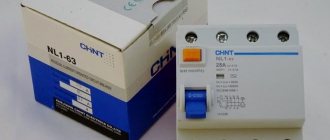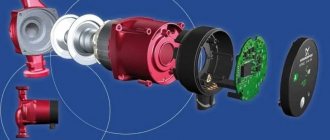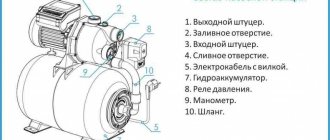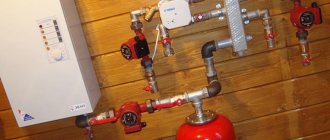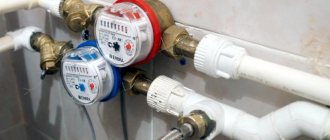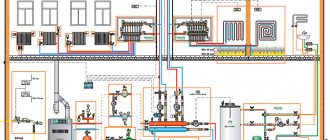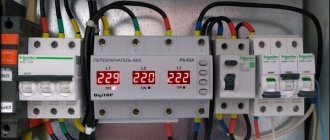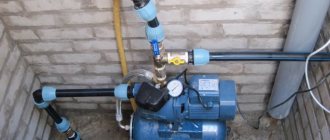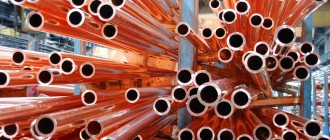In the absence of a centralized water main, residential building owners have to solve the water supply problem themselves by digging wells or drilling wells. Often, owners are faced with the problem of a small flow rate (volume of incoming water) of a source, for the exit from which a storage tank for water supply is used.
In order to effectively provide a home with water using a storage tank, the owner will have to solve a number of difficult problems in choosing a tank, its installation location, additional pumping equipment and automation devices, and connection diagrams. In order to avoid making critical mistakes, you should carefully study all the information on the use of storage tanks in autonomous water supply systems.
Rice. 1. Plastic storage tanks
Storage tank - what is it, purpose, application
Water, along with light and heat, is the primary factor in the life support of a home. Therefore, the slightest violation in her usual method of delivery leads to extreme discomfort. Until recently, the only way to solve this problem was to reserve a certain amount of water in bottles, canisters, and barrels. However, if not used for everyday needs, it quickly deteriorates and becomes unsuitable for drinking and cooking.
A modern way to solve this problem is a special water storage tank for the home, combined with both a centralized water supply and water intake from a well, well or natural reservoir. Such a reserve tank is used in the following series of cases:
- Periodic or emergency shutdown of centralized water supply, as well as when water is supplied not constantly, but according to a schedule.
- Low performance of an autonomous source.
- Frequent shutdowns of pumping stations due to power failures.
Drives can be very different in capacity, depending on the needs of the consumer Source ireland.apollo.com
- Clogging, silting and other technical malfunctions of a well or well.
- The supply system is completely autonomous - it functions only using imported water.
The peculiarity of a private water supply is such that these and many other small reasons can arise one after another, and sometimes simultaneously. At the same time, troubleshooting always requires a certain period of time, sometimes reaching several days or weeks.
In addition to ensuring stability in the water supply, the storage tank performs a number of other technical functions that are essential for equipment, fittings and pipelines:
- Equalizing pressure in the system.
- Prevention of water hammer.
- Reducing the load on pumps and their operating time.
- Increased equipment service life.
Advice! To conveniently and quickly activate the reserve water supply, the reserve tank must be connected to the water supply so that if the main supply is interrupted, the additional one is turned on automatically or by turning the valve.
The storage tank can be easily integrated into the home water supply scheme Source oboiman.ru
The best storage water heaters for 100 liters
Large-volume boilers are most often in demand in residential premises where there is no water or the supply occurs very rarely, in dachas and country houses. Also, a large device is in demand in families where the number of members is more than 4 people. Any of the 100 liter storage water heaters proposed by experts will allow you to bathe and perform household tasks with hot water without turning it on again.
Zanussi ZWH/S 100 Splendore XP 2.0
A rectangular compact boiler with a large capacity will allow you not to limit yourself in water procedures, while saving energy and free space in the room. Stainless steel will protect against contamination, damage, and corrosion. For comfortable control, there is an electronic Smart system, display, light indication and thermometer. Power of Zanussi ZWH/S 100 Splendore XP 2.0 2000 W, the check valve will withstand pressure up to 6 atmospheres. Protective functions will protect the device from dry operation, overheating, scale and corrosion. It will take an average of 225 minutes to bring the water to 75 degrees.
Advantages
- Compact and light weight;
- Clear controls;
- Water sanitary treatment system;
- Timer;
- Safety.
Flaws
- Price.
Maximum heating accuracy down to the degree ensures uninterrupted, stable operation. Good thermal insulation and anti-freezing maintain the integrity of the housing, and this guarantees a long service life. The manufacturer notes that the water inside the tank is disinfected. A good check valve and RCD are installed inside the Zanussi ZWH/S 100 Splendore XP 2.0.
Ariston ABS VLS EVO PW 100
This model demonstrates impeccable aesthetics and laconic design. The snow-white steel body in the shape of a rectangle does not take up as much space as round boilers with greater depth. The increased power of 2500 W guarantees heating to 80 degrees much faster than expected. Installation can be either vertical or horizontal. For clear control there is a light indication, an electronic display with information and an option for accelerated operation. Safety is ensured by a temperature limiter, overheat protection, check valve, and auto shut-off. Unlike other nominees, there is self-diagnosis.
Advantages
- Convenient form factor;
- 2 anodes and heating element with silver for water disinfection;
- Increased power and fast heating;
- Display for control;
- Good security parameters;
- Exposure to 8 atmospheres of water pressure.
Flaws
- No fasteners included;
- Unreliable display electronics.
In terms of quality and functions, this is an impeccable device for home use, which is confirmed by numerous reviews. The control system is not so durable; after some time it may provide inaccurate information. But this does not affect the performance and safety of the Ariston ABS VLS EVO PW 100 boiler.
Stiebel Eltron PSH 100 Classic
The device guarantees a high level of performance, classic design and quality. With a volume of 100 liters, it can operate at a power of 1800 W, heating water in the range of 7-70 degrees, the desired option is set by the user. The heating element is made of copper, resistant to mechanical stress and corrosion. The water pressure should not exceed 6 atmospheres. The device is equipped with protective elements and systems against corrosion, scale, freezing, overheating, a thermometer, and a mounting bracket.
Advantages
- Low heat loss;
- Durability of service;
- High security;
- Easy installation;
- Convenient control;
- Possibility of setting the optimal temperature.
Flaws
- There is no built-in RCD;
- Installation of a relief valve may be required.
Unlike many nominees, this device can set the water heating mode to 7 degrees. The boiler does not consume as much electricity, maintaining heat longer due to the polyurethane coating. The inlet pipe inside the structure provides 90% of unmixed water in the tank, which also protects the water from quickly cooling.
Design and principle of operation
A storage tank for water is a reservoir of a certain volume, equipped with the following devices:
- Inlet tube. Through it, the reservoir is filled from the main source - a well or a central pipeline.
- Float mechanism. This can be a regular float, similar to the device of a toilet flush cistern, or a special valve that, when the tank is full, turns off the supply pump or closes the tap.
- Drain pipe. To prevent the container from overfilling and causing flooding of the room, in case the float mechanism does not work, a drain tube is installed in the upper part, through which excess water is removed.
- Filter. There are several types of filter devices installed on the inlet artery - mesh, cyclonic and centrifugal type. The first is used when there is slight contamination, the last two are used when there are impurities visible to the naked eye. The filter mesh can also be mounted on the outlet pipe from the tank.
Modern filtration system for a storage tank Source terman-s.ru
- Drainage and cleaning tube. When using a container for a long time, even with a good filter, a layer of contaminating deposits inevitably accumulates at the bottom. A drainage pipe is used to periodically remove them.
- Luke. If a private house has a basement or basement, then a water storage tank is often installed there. However, with such a low location of the tank, it is almost impossible to install a drainage system. Therefore, for periodic cleaning, a hatch is required in the upper part, through which you can penetrate inside and clean the bottom of dirt.
- Diffuser. A device that disperses water flow similar to a watering can. Installed on the supply tube. Prevents active mixing of the upper layers with bottom sediments.
- Level. As a rule, the walls of the tank are opaque. Therefore, to accurately determine its fullness, a level is mounted.
Design of a membrane storage tank Source montagtrub.ru
See also: Catalog of companies that specialize in garden furniture and storage systems
- Ventilation pipe. Regardless of whether the container is equipped with a hatch or not, when closed it is a hermetically sealed capsule. Therefore, so that when opening the tap, an internal vacuum of air does not form, and this results in water retention, a ventilation valve or tube is installed in the very top part.
The mechanism of action of the reserve tank is largely determined by its location - if it is located at a sufficiently high level in relation to the receiver (faucet, shower, etc.), water can flow out of it by gravity, if lower or at the level, then under the pressure generated a pump specially installed for this purpose.
The best storage water heaters for 50 liters
The next popular category of such equipment is boilers with a capacity of 50 liters. They are preferred to be installed not only in dachas or in small families, but also in ordinary apartments with a large number of users. There is enough warm water for washing dishes, for morning hygiene procedures, and even for a full shower. Customer reviews and expert reviews will help you choose a high-quality storage water heater.
Zanussi ZWH/S 50 Smalto DL
An electric device for storing and heating water belongs to the middle price segment. With a capacity of 5L, it can boost power up to 1500W. The heating speed is average, 50 liters can be brought to 75 degrees in 90-96 minutes. The optimal water pressure should not exceed 6 atmospheres or be below 0.8 atmospheres. The difference between the Zanussi ZWH/S 50 Smalto DL and its competitors is that there are 2 enameled tanks inside. Can be placed on the wall either vertically or horizontally. There is a display showing the heating level, a light indicator, an anode inside to protect against corrosion, safety systems against drips, and work without water.
Advantages
- There are 2 tanks inside;
- High degree of security;
- Multifunctional technology;
- Thermal insulation;
- Strong durable materials;
- Automatic maintenance of the selected temperature.
Flaws
- There is no valve for draining water;
- Heavy weight.
If you use the tank in the first water heating mode, it reaches the desired temperature, and then can switch to an economical mode. It is possible to manually set the desired degrees, after which the device will operate in energy-saving mode. If there is no cold water in the apartment, the tank will stop working.
Ariston ABS VLS EVO INOX PW 50
Storage type heater. The stainless steel tank, resistant to corrosion and destruction, is equipped with two powerful heating elements with a power of 2500 W, as well as a reservoir of up to 50 liters of water. Ariston ABS VLS EVO INOX PW 50 can be mounted horizontally or vertically on the wall. Unlike previously presented devices, here the maximum heating rate is 80 degrees. Ease of control is due to the electronic system.
Advantages
- Beautiful design, flat body;
- Silent execution of tasks;
- Fast warm-up;
- Easy installation;
- Data display;
- High-quality valve included for protection;
- Function for setting power modes.
Flaws
- Heavy weight;
- The price is higher than some competitors.
For a small family, this device will be a sufficient hot water tank. And although the Ariston 50-liter storage water heater has a display and a simple control system, you still need to read the instructions before starting operation.
The best air conditioners for home and apartment according to customer reviews
Varieties
Reserve tanks to ensure uninterrupted water supply are classified according to the following number of parameters:
- Shape - can be cylindrical, rectangular, square, etc.
- Type of construction - open and closed type, that is, with and without a hatch - completely sealed membrane.
- There are various types of housing material used – from stainless steel to food-grade plastic. At the same time, its composition must exclude harmful substances that can pass into water.
Storage containers most often have a plastic body Source septik.guru
- Capacities - depending on the conditions of use, the useful volume can be very different - from 10 liters to 1 m³, etc. It is also possible to combine several containers into one system.
- Purpose - for drinking and cooking, for watering the garden, for the heating system, for cold or hot water supply, for other technical needs.
- Installation features - vertical or horizontal placement, indoors or outdoors, on the surface, at height or underground.
Note! To ensure uninterrupted water supply to a private home, it is not necessary to purchase and install an additional pump for a storage tank. Special membrane hydraulic accumulators create a certain pressure - sufficient for convenient use of a tap, shower and other household needs.
Safety
It is imperative to ground the boiler.
Any water heater, regardless of model and type, requires compliance with operating conditions, as well as safety precautions. Gas models have an increased danger, as there is a risk of gas leakage.
Contact with water is the main risk factor when operating any electrical product. The boiler is equipped with an automatic shutdown system upon contact with liquid, but this does not negate compliance with the simplest fire and electrical safety requirements.
It is important to make grounding in advance. Installation of a grounding wire is a basic and mandatory condition for the safety of an electrical appliance.
Capacity volume and material
When choosing a drive, in addition to other technical nuances, you first need to determine what material its body should be made of and what its usable volume should be for everyday needs.
A plastic container can be installed outdoors without additional protection Source sovet-ingenera.com
Material
Most often, the materials used in the manufacture of the tank body are:
- Polyvinyl chloride.
- Polypropylene.
- Cross-linked polyethylene.
- Stainless steel.
- Steel coated with a layer of waterproof coating - varnish, ceramics.
- Galvanization.
To equip drinking water supply and related household needs (washing dishes, showering, etc.) for a private home, food-grade plastic containers are most often chosen. Its main advantages over metal analogues are inertness, safety (does not emit harmful components), corrosion resistance, durability, light weight - which is convenient for transportation, installation and maintenance.
Features of tanks manufactured using different technologies
Containers made of structural polymers (polyethylene, polypropylene, polystyrene, polyvinyl chloride plastic compound, ethylene copolymers) are made from:
- sheet blanks using welding methods (resistance butt, lap, T-welding) and thermoforming (simplified by extrusion, stamping of a heated sheet);
- granules or powder by blow and rotational molding.
Conventionally, one-piece “seamless” tanks are manufactured using thermal blowing and rotational molding technologies, which have their own advantages and disadvantages, summarized in the table below.
Water tanks made by connecting individual structural elements by butt welding, overlapping, have lower strength compared to rotomolding, which is taken into account by using the correction factor ϕsh in the calculations, which ranges from 0.35 and 0.4 for vinyl plastic and polystyrene (respectively) to 0.9 for polyethylene. The strength (coefficient 1.0) is not reduced only for tanks manufactured using “seamless” rotomoulding technology, essentially solid cast.
Connection options
There are two main options for connecting a water storage tank in your home:
- Together with the central water supply.
- As part of an autonomous water supply system.
Moreover, in each of the schemes there are several options for installing the tank. Let's look at them in more detail.
Scheme of autonomous water supply with a membrane tank Source moikolodets.ru
Combination with centralized water supply
When the source of water supply is the central water supply, the reserve tank ensures an uninterrupted supply of water in the event of a power outage or reduction in pressure. In this case, there are 3 main ways to connect the tank:
- Upper.
The container can be installed either under the ceiling on the 1st floor or on the floor of the 2nd, in the attic or in the attic. In any case, the outlet pipe must be higher than the level of the water intake source - tap, toilet, etc. The tank must be equipped with 3 fittings:
- The top one is for filling.
- Extremely upper - to drain water in case of overflow.
- Bottom - for supply to the house water supply.
Water is supplied to the container through a tee installed immediately after the filter, meter and check valve. Next, the pipe from it is connected to the upper fitting through a valve and a float mechanism. The lower fitting is connected to the house water supply through a shut-off valve and a tee via a pipe.
Video description
Video example of arranging a home water supply system using a storage tank:
Only one pipe is used for connection. Its installation location is the same as in previous cases - after the filter, meter and valve. In this case, for correct installation it is necessary to first adjust the pressure of the internal chamber. It must correspond to the operating pressure of the water supply.
Arrangement of autonomous water supply
There are several options for connection:
- Like a water tower.
The storage tank is installed in the attic, the top floor of a private house or a tower specially built for this purpose, and water is supplied to it by means of a pump. In this case, to achieve normal pressure, the lower outlet pipe must be located above the ground at least 10-15 meters. The pressure in the system is determined by the difference in height between the container and the receiver.
The main advantage of this water supply option is the minimum cost. The disadvantage is the need to regularly clean the tank from accumulated sediment, as well as mandatory insulation if it is located outside a heated room.
Where are water tanks installed?
The choice of location for storage tanks depends on many factors that must be taken into account when planning installation work.
- You can provide backup water supply to a private home through a storage tank by installing the tank in a utility room under the ceiling.
- Install a water tank in the attic or loft. If necessary, the structure will have to be insulated.
- Place it directly on the floor surface or in the basement. Without a pumping station, of course, such a scheme will not work.
Video description
Video instructions on how to make pressurized water supply to your home and property through a membrane storage tank:
- Lower.
The container is installed on the floor or on the ground. Filled under pump pressure. Operation of the system also requires constant operation of the equipment. Which makes the water supply completely energy dependent.
This option is ideal for low well productivity. First, the tank is pumped at a speed limited by the parameters of the source, and then it is consumed according to consumer needs.
- Membrane accumulator.
This is another way to supply water from the lower location of the storage tank when the system is not equipped with a pump. Initially, water is drawn into the container from the well, and then enters and is distributed through the internal water supply under the influence of pressure generated by the membrane accumulator.
On a note! When placing a tank in an attic, tower, basement or any other unheated place, insulation and a suitable heating system are required - both inlet and outlet pipes and the body.
Main types of breakdowns
Modern manufacturers have learned to create excellent luxury water heating equipment. It uses gas to operate efficiently and rarely fails. However, even the best gas heaters cannot avoid breakdowns. The list of inevitable malfunctions includes:
- water leaks;
- poor heating of the liquid;
- discharge of power elements;
- weak water pressure;
- lack of gas.
Owners of gas boilers can repair some faults themselves. Anyone can change the batteries in the power supply. It is also easy to eliminate weak water pressure - perhaps excess scale has simply formed in the heat exchanger. To remove it, remove the heat exchanger and rinse thoroughly. For these purposes, you can also use special descaling liquids.
It is not difficult to solve the problem of poor water heating on your own. The main reason for such a malfunction is often contamination of the heat exchanger with soot. The solution to this problem is to remove the mentioned element and remove plaque. If more significant problems occur, you should contact a professional.
Briefly about the main thing
The storage tank ensures constant water supply in a private home in the event of a planned or sudden shutdown of the central water supply or breakdown of the autonomous system. It eliminates the problems of water supply failure associated with a number of the following reasons - low well productivity, equipment breakdown, siltation of the source, power outage, etc. In addition, it reduces the load on equipment and pipes and extends their service life.
A standard water tank consists of the following elements:
- Cases.
- Inlet, outlet and drain tubes.
- Float mechanism.
- Filter.
- Luke.
- Drainage pipe.
- Diffuser.
- Ventilation.
The tank is classified according to several criteria - shape, design, material, volume, purpose, installation method. When choosing it, volume and material are first taken into account. Installation is possible both in an autonomous system and in conjunction with a centralized water supply. In each case there are several installation methods.
Ratings 0
Recommendations
When planning to purchase a storage tank and organize its operation in the house, it is worth enlisting the advice of experienced specialists:
- Combine the purchase of a water storage device with the purchase of a filtration device. This way you can get crystal clear drinking liquid. When considering offers on the market, you should pay attention to products. We manufacture and sell water treatment equipment and are ready to help you choose the option that suits you.
- When choosing a water storage tank, do not skimp on quality. If you buy a cheap product, you will probably spend more money on troubleshooting various problems.
- When doing the installation yourself, consider the possibility of dismantling the system for repairs or replacement.
- Be sure to consider grounding to prevent corrosion.
